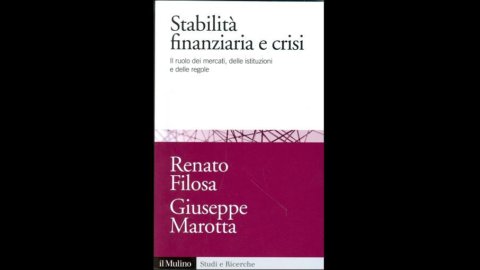"At regular intervals, the last thirty years have been punctuated by serious financial crises affecting individual countries, extended geographical areas or, as in the case of the current crisis, the entire world economy". These are the introductory words to the volume by Renato Filosa and Giuseppe Marotta, former director of the Bank of Italy and various international institutions the former, and professor of monetary economics at the University of Modena and Reggio Emilia the latter.
In the volume the emphasis is placed on the theme of financial crises, which the authors address with an extremely rigorous scientific methodology, taking care not to fall into easy trivializations or simplifications from "financial news".
The book, divided into seven chapters and enriched by some substantial final appendices, can be easily divided into two macro-areas.
The first, comprising the four initial chapters, follows a purely deductive logic: from the description of a situation of equilibrium, in which the concept of monetary and financial stability is explored, with the related policies that can be implemented, up to the analysis of structured finance, pivotal in the last crisis that developed in 2007. In the middle - in chapters 2 and 3 - there are the definition of some theoretical models which better highlight the interweaving of concomitant causes in periods of instability, and theexposition of the crises that occurred in the eighties and nineties of the last century in emerging countries (Mexico, South East Asia, Argentina) and in advanced countries (United States, Scandinavia, Japan).
In this first part, in which the reader is gradually introduced into complex financial mechanics, Filosa and Marotta wanted to offer on the one hand some necessary analytical tools, extrapolated to a large extent from economic theory, on the other the observation of various and significant economic realities, in order to demonstrate the inadequacy of individual models in interpreting the genesis and dynamics of crises.
In the second part of the volume, made up of three chapters, the interest is focused on the various measures that "make it possible to reduce the probability of a crisis occurring, limiting its scope and facilitating its resolution". The main regulatory instruments that guarantee financial stability are then described, while protecting the saver-investor. Particular attention is paid to the role of banks and to micro and macro prudential regulation: the fundamental task assigned to supervision, but also the proper functioning of the safety net, the purpose of which is to instill confidence and contain possible negative effects of potential financial meltdowns.
The last chapter of the book is dedicated to some reform proposals, prompted by the recent crisis of 2007, with a constant focus on the peculiarities of the global banking system: endogenous strengths and weaknesses.
Filosa and Marotta maintain, throughout the writing, a neo-institutionalist approach to economic and financial relations, according to which stability and general economic equilibrium directly depend on the level of trust that institutions and regulatory instruments are capable of instilling in operators, correcting their deviant behavior and adopting timely reforms where necessary.
Overall, the work aims to represent an incentive to financial education as an element of greater knowledge of the citizen-investor. "The contribution that the volume aspires to offer in this field - referring the authors to the economic investigation in conditions of instability - is to acquire an adequate awareness of the multiplicity of factors, but at the same time of the few basic keys for their interpretation" .
Accurate and carefully selected historical references, use of analytical-mathematical tools, linear and well-presented research questions, are all useful ingredients to make this volume an excellent example of union between scientific work and the investor's "handbook". All accompanied by an expository clarity that never degenerates into simplistic constructs.
Title: Financial stability and crisis
Author: Renato Filosa and Giuseppe Marotta
Publisher: The Mill
Necklace: Studies and Research
Release date: 08/09/2011
Pages: 392, paperback
Italian language
ISBN: 978-88-15-23305-9
Price list: €30,00





